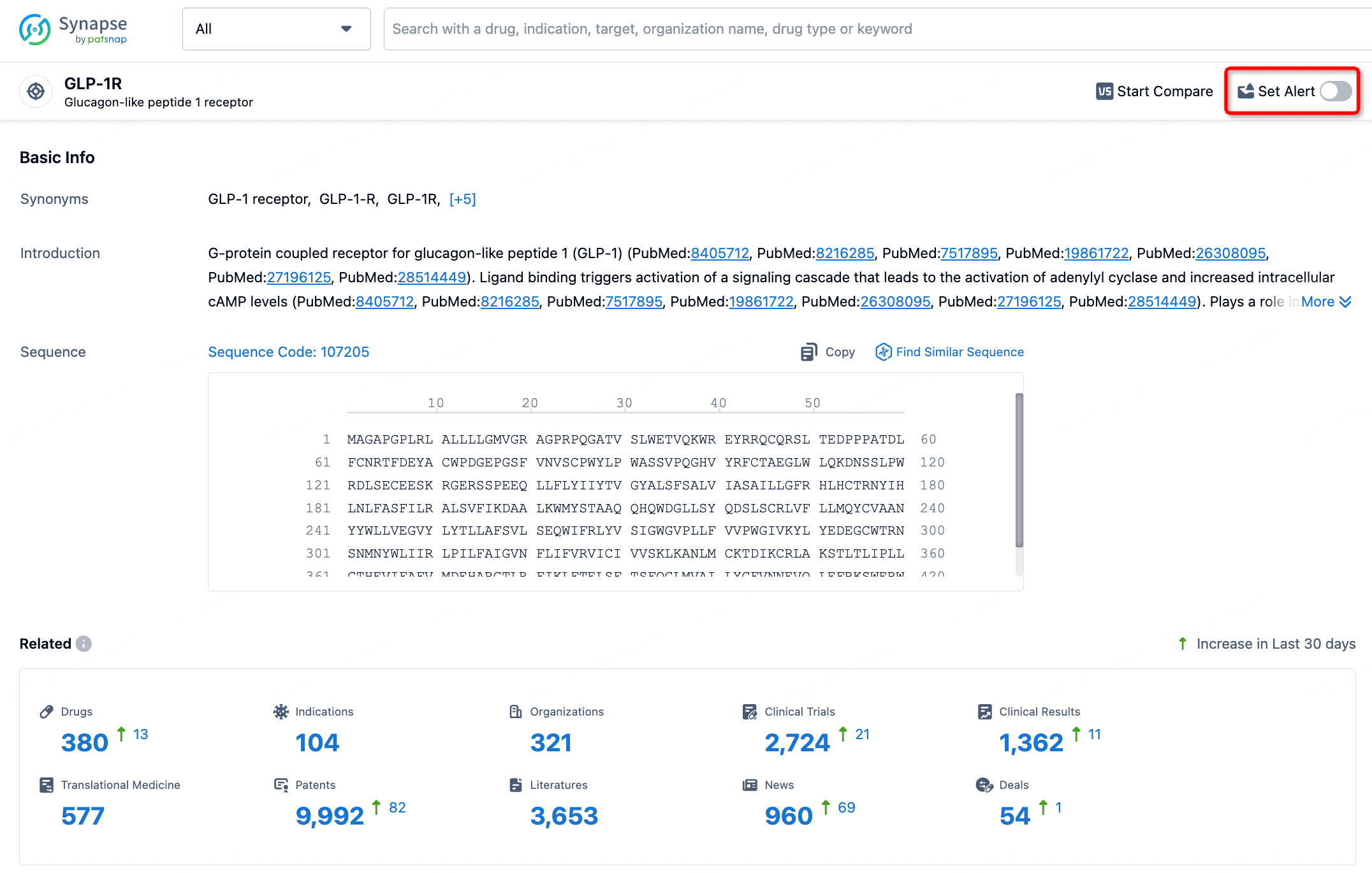Request Demo
What are SSTR3 agonists and how do they work?
21 June 2024
Introduction to SSTR3 Agonists
In recent years, the scientific community has shown a growing interest in somatostatin receptor 3 (SSTR3) agonists due to their potential therapeutic applications. Somatostatin receptors, including SSTR3, are part of a family of G-protein-coupled receptors that play a crucial role in modulating endocrine and nervous system functions. Somatostatin itself is a peptide hormone that inhibits the release of various other hormones and neurotransmitters. SSTR3 agonists are compounds that selectively bind to and activate the SSTR3 receptor, leading to various biological effects. Their ability to precisely target this receptor subtype makes them promising candidates for treating a range of medical conditions.
How Do SSTR3 Agonists Work?
Understanding the mechanism of action of SSTR3 agonists involves delving into the complex interplay between somatostatin receptors and cellular signaling pathways. Upon binding to the SSTR3 receptor, these agonists activate intracellular signaling cascades primarily mediated by G-proteins. This activation leads to the inhibition of adenylate cyclase, a reduction in cyclic AMP (cAMP) levels, and subsequent modulation of ion channels and protein kinase activity. These molecular events result in various physiological outcomes, such as the inhibition of hormone secretion, modulation of neuronal excitability, and regulation of cell proliferation.
One of the key features of SSTR3 agonists is their ability to exert inhibitory effects on hormone secretion. For instance, in the endocrine system, SSTR3 activation can suppress the release of growth hormone, insulin, and glucagon. In the nervous system, SSTR3 agonists can reduce the release of neurotransmitters like serotonin and dopamine, thereby influencing neuronal communication and potentially offering therapeutic benefits for neurological disorders.
What Are SSTR3 Agonists Used For?
The therapeutic potential of SSTR3 agonists is vast and varied, encompassing several medical fields. One of the most well-researched applications is in the treatment of neuroendocrine tumors (NETs). These tumors, which can arise in the pancreas, gastrointestinal tract, and other organs, often express high levels of somatostatin receptors, including SSTR3. By selectively activating these receptors, SSTR3 agonists can inhibit tumor growth and hormone secretion, helping to manage symptoms and potentially slow disease progression.
In addition to their role in oncology, SSTR3 agonists are being investigated for their utility in managing metabolic disorders. Given their ability to suppress insulin and glucagon secretion, these agonists hold promise for treating conditions like diabetes and obesity. By modulating hormone levels, SSTR3 agonists could help regulate blood glucose levels and reduce hyperinsulinemia, offering a novel approach to metabolic disease management.
Neurological applications of SSTR3 agonists are also gaining attention. Their ability to modulate neurotransmitter release suggests potential benefits in treating disorders such as epilepsy, depression, and anxiety. Preclinical studies have shown that SSTR3 activation can reduce neuronal excitability and seizure susceptibility, providing a foundation for future clinical research in this area. Additionally, the anti-proliferative effects of SSTR3 agonists are being explored for their potential to treat neurodegenerative diseases, where abnormal cell growth and differentiation play a role.
Beyond these applications, SSTR3 agonists are being studied for their potential in treating inflammatory and autoimmune diseases. Somatostatin receptors are involved in regulating immune responses, and SSTR3 activation has been shown to exert anti-inflammatory effects. This opens up possibilities for using SSTR3 agonists to treat conditions like rheumatoid arthritis, inflammatory bowel disease, and other autoimmune disorders.
In conclusion, SSTR3 agonists represent a promising frontier in medical research, with potential applications spanning oncology, endocrinology, neurology, and immunology. Their ability to selectively target and modulate the SSTR3 receptor offers a therapeutic approach that could revolutionize the treatment of various diseases. As research progresses, the full scope of their clinical utility will become clearer, paving the way for new and innovative therapies.
In recent years, the scientific community has shown a growing interest in somatostatin receptor 3 (SSTR3) agonists due to their potential therapeutic applications. Somatostatin receptors, including SSTR3, are part of a family of G-protein-coupled receptors that play a crucial role in modulating endocrine and nervous system functions. Somatostatin itself is a peptide hormone that inhibits the release of various other hormones and neurotransmitters. SSTR3 agonists are compounds that selectively bind to and activate the SSTR3 receptor, leading to various biological effects. Their ability to precisely target this receptor subtype makes them promising candidates for treating a range of medical conditions.
How Do SSTR3 Agonists Work?
Understanding the mechanism of action of SSTR3 agonists involves delving into the complex interplay between somatostatin receptors and cellular signaling pathways. Upon binding to the SSTR3 receptor, these agonists activate intracellular signaling cascades primarily mediated by G-proteins. This activation leads to the inhibition of adenylate cyclase, a reduction in cyclic AMP (cAMP) levels, and subsequent modulation of ion channels and protein kinase activity. These molecular events result in various physiological outcomes, such as the inhibition of hormone secretion, modulation of neuronal excitability, and regulation of cell proliferation.
One of the key features of SSTR3 agonists is their ability to exert inhibitory effects on hormone secretion. For instance, in the endocrine system, SSTR3 activation can suppress the release of growth hormone, insulin, and glucagon. In the nervous system, SSTR3 agonists can reduce the release of neurotransmitters like serotonin and dopamine, thereby influencing neuronal communication and potentially offering therapeutic benefits for neurological disorders.
What Are SSTR3 Agonists Used For?
The therapeutic potential of SSTR3 agonists is vast and varied, encompassing several medical fields. One of the most well-researched applications is in the treatment of neuroendocrine tumors (NETs). These tumors, which can arise in the pancreas, gastrointestinal tract, and other organs, often express high levels of somatostatin receptors, including SSTR3. By selectively activating these receptors, SSTR3 agonists can inhibit tumor growth and hormone secretion, helping to manage symptoms and potentially slow disease progression.
In addition to their role in oncology, SSTR3 agonists are being investigated for their utility in managing metabolic disorders. Given their ability to suppress insulin and glucagon secretion, these agonists hold promise for treating conditions like diabetes and obesity. By modulating hormone levels, SSTR3 agonists could help regulate blood glucose levels and reduce hyperinsulinemia, offering a novel approach to metabolic disease management.
Neurological applications of SSTR3 agonists are also gaining attention. Their ability to modulate neurotransmitter release suggests potential benefits in treating disorders such as epilepsy, depression, and anxiety. Preclinical studies have shown that SSTR3 activation can reduce neuronal excitability and seizure susceptibility, providing a foundation for future clinical research in this area. Additionally, the anti-proliferative effects of SSTR3 agonists are being explored for their potential to treat neurodegenerative diseases, where abnormal cell growth and differentiation play a role.
Beyond these applications, SSTR3 agonists are being studied for their potential in treating inflammatory and autoimmune diseases. Somatostatin receptors are involved in regulating immune responses, and SSTR3 activation has been shown to exert anti-inflammatory effects. This opens up possibilities for using SSTR3 agonists to treat conditions like rheumatoid arthritis, inflammatory bowel disease, and other autoimmune disorders.
In conclusion, SSTR3 agonists represent a promising frontier in medical research, with potential applications spanning oncology, endocrinology, neurology, and immunology. Their ability to selectively target and modulate the SSTR3 receptor offers a therapeutic approach that could revolutionize the treatment of various diseases. As research progresses, the full scope of their clinical utility will become clearer, paving the way for new and innovative therapies.
How to obtain the latest development progress of all targets?
In the Synapse database, you can stay updated on the latest research and development advances of all targets. This service is accessible anytime and anywhere, with updates available daily or weekly. Use the "Set Alert" function to stay informed. Click on the image below to embark on a brand new journey of drug discovery!
AI Agents Built for Biopharma Breakthroughs
Accelerate discovery. Empower decisions. Transform outcomes.
Get started for free today!
Accelerate Strategic R&D decision making with Synapse, PatSnap’s AI-powered Connected Innovation Intelligence Platform Built for Life Sciences Professionals.
Start your data trial now!
Synapse data is also accessible to external entities via APIs or data packages. Empower better decisions with the latest in pharmaceutical intelligence.


